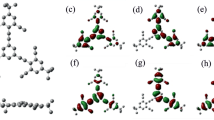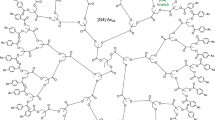Abstract
Dendrimers made of oligo(phenylene ethynylene) building blocks are highly organised two-dimensional macromolecules that have raised much interest for their potential use as artificial light-harvesting antennae. Excitation-energy transfer is assumed to occur from the periphery to the core via a tree-shaped graph connecting a pair of donors on each acceptor. The received photophysical mechanism involves a converging cascade of crossings among bright electronic states foremost mediated by rigid acetylenic stretching modes. On the other hand, competition with in-plane trans-bending motions has been detected experimentally in oligomers and confirmed by computations in larger species, thus suggesting the additional involvement of dark electronic states acting as intermediates. In the present work, we show that this secondary process represents an alternative pathway that may not be detrimental and could even be viewed as a mechanistic shortcut.














Similar content being viewed by others
Data availability statement
The datasets generated during and/or analysed during the current study are available from the corresponding author on reasonable request.
References
C. Weder, G. Voskerician, Electronic properties of PAEs, in Poly(arylene etynylene)s: From Synthesis to Application. Advances in Polymer Science, ed. by C. Weder (Springer, Berlin, Heidelberg, 2005), pp. 209–248 https://doi.org/10.1007/b101379
A. Bar-Haim, J. Klafter, R. Kopelman, Dendrimers as controlled artificial energy antennae. J. Am. Chem. Soc. 119, 6197–6198 (1997). https://doi.org/10.1021/ja970972f
D. Astruc, E. Boisselier, C. Ornelas, Dendrimers designed for functions: from physical, photophysical, and supramolecular properties to applications in sensing, catalysis, molecular electronics, photonics, and nanomedicine. Chem. Rev. 110, 1857–1959 (2010). https://doi.org/10.1021/cr900327d
R. Kopelman, M. Shortreed, Z.-Y. Shi, W. Tan, Z. Xu, J.S. Moore, A. Bar-Haim, J. Klafter, Spectroscopic evidence for excitonic localization in fractal antenna supermolecules. Phys. Rev. Lett. 78, 1239–1242 (1997). https://doi.org/10.1103/PhysRevLett.78.1239
M.R. Shortreed, S.F. Swallen, Z.-Y. Shi, W. Tan, Z. Xu, C. Devadoss, J.S. Moore, R. Kopelman, Directed energy transfer funnels in dendrimeric antenna supermolecules. J. Phys. Chem. B 101, 6318–6322 (1997). https://doi.org/10.1021/jp9705986
V.D. Kleiman, J.S. Melinger, D. McMorrow, Ultrafast dynamics of electronic excitations in a light—harvesting phenylacetylene dendrimer. J. Phys. Chem. B 105, 5595–5598 (2001). https://doi.org/10.1021/jp010208m
E. Atas, Z. Peng, V.D. Kleiman, Energy transfer in unsymmetrical phenylene ethynylene dendrimers. J. Phys. Chem. B 109, 13553–13560 (2005). https://doi.org/10.1021/jp051488z
J.L. Palma, E. Atas, L. Hardison, T.B. Marder, J.C. Collings, A. Beeby, J.S. Melinger, J.L. Krause, V.D. Kleiman, A.E. Roitberg, Electronic spectra of the nanostar dendrimer: theory and experiment. J. Phys. Chem. C 114, 20702–20712 (2010). https://doi.org/10.1021/jp1062918
J. Huang, L. Du, D. Hu, Z. Lan, Theoretical analysis of excited states and energy transfer mechanism in conjugated dendrimers. J. Comput. Chem. 36, 151–163 (2015). https://doi.org/10.1002/jcc.23778
V.M. Freixas, D. Ondarse-Alvarez, S. Tretiak, D.V. Makhov, D.V. Shalashilin, S. Fernandez-Alberti, Photoinduced non-adiabatic energy transfer pathways in dendrimer building blocks. J. Chem. Phys. 150, 124301 (2019). https://doi.org/10.1063/1.5086680
C. Azarias, L. Cupellini, A. Belhboub, B. Mennucci, D. Jacquemin, Modelling excitation energy transfer in covalently linked molecular dyads containing a BODIPY unit and a macrocycle. Phys. Chem. Chem. Phys. 20, 1993–2008 (2018). https://doi.org/10.1039/C7CP06814J
S. Tomasi, I. Kassal, Classification of coherent enhancements of light-harvesting processes. J. Phys. Chem. Lett. 11, 2348–2355 (2020). https://doi.org/10.1021/acs.jpclett.9b03490
E.K.L. Ho, B. Lasorne, Diabatic pseudofragmentation and nonadiabatic excitation-energy transfer in meta-substituted dendrimer building blocks. Comput Theoretical Chem 1156, 25–36 (2019). https://doi.org/10.1016/j.comptc.2019.03.013
Y. Hirata, T. Okada, N.T. Mataga, Picosecond time-resolved absorption spectrum measurements of the higher excited singlet state of diphenylacetylene in the solution phase. J. Phys. Chem. 96, 6559–6563 (1992). https://doi.org/10.1021/j100195a011
M.Z. Zgierski, E.C. Lim, Nature of the ‘dark’ state in diphenylacetylene and related molecules: state switch from the linear ππ* state to the bent πσ* state. Chem. Phys. Lett. 387, 352–355 (2004). https://doi.org/10.1016/j.cplett.2004.02.029
J. Saltiel, V.K.R. Kumar, Photophysics of diphenylacetylene: light from the-dark state. J. Phys. Chem. A 116, 10548–10558 (2012). https://doi.org/10.1021/jp307896c
M. Krämer, U.H.F. Bunz, A. Dreuw, Comprehensive look at the photochemistry of tolane. J. Phys. Chem. A 121, 946–953 (2017). https://doi.org/10.1021/acs.jpca.6b09596
C. Robertson, G.A. Worth, Modelling the non-radiative singlet excited state isomerization of diphenyl-acetylene: a vibronic coupling model. Chem. Phys. 510, 17–29 (2018). https://doi.org/10.1016/j.chemphys.2018.04.020
T. Fujiwara, M.Z. Zgierski, E.C. Lim, Spectroscopy and photophysics of 1,4-bis (phenylethynyl)benzene: effects of ring torsion and dark πσ* state. J. Phys. Chem. A 112, 4736–4741 (2008). https://doi.org/10.1021/jp711064g
G. Breuil, E. Mangaud, B. Lasorne, O. Atabek, M. Desouter-Lecomte, Funneling dynamics in a phenylacetylene trimer: coherent excitation of donor excitonic states and their superposition. J. Chem. Phys. 155, 034303 (2021). https://doi.org/10.1063/5.0056351
C. Adamo, D. Jacquemin, The calculations of excited-state properties with time-dependent density functional theory. Chem Soc. Rev. 42, 845–856 (2013). https://doi.org/10.1039/C2CS35394F
E.K.-L. Ho, T. Etienne, B. Lasorne, Vibronic properties of para-polyphenylene ethynylenes: TD-DFT insights. J. Chem. Phys. 146, 164303 (2017). https://doi.org/10.1063/1.4981802
M. J. Frisch, G. W. Trucks, H. B. Schlegel, G. E. Scuseria, M. A. Robb, J. R. Cheeseman, G. Scalmani, V. Barone, G. A. Petersson, H. Nakatsuji, X. Li, M. Caricato, A. V. Marenich, J. Bloino, B. G. Janesko, R. Gomperts, B. Mennucci, H. P. Hratchian, J. V. Ortiz, A. F. Izmaylov, J. L. Sonnenberg, D. Williams-Young, F. Ding, F. Lipparini, F. Egidi, J. Goings, B. Peng, A. Petrone, T. Henderson, D. Ranasinghe, V. G. Zakrzewski, J. Gao, N. Rega, G. Zheng, W. Liang, M. Hada, M. Ehara, K. Toyota, R. Fukuda, J. Hasegawa, M. Ishida, T. Nakajima, Y. Honda, O. Kitao, H. Nakai, T. Vreven, K. Throssell, J. A. Montgomery, Jr., J. E. Peralta, F. Ogliaro, M. J. Bearpark, J. J. Heyd, E. N. Brothers, K. N. Kudin, V. N. Staroverov, T. A. Keith, R. Kobayashi, J. Normand, K. Raghavachari, A. P. Rendell, J. C. Burant, S. S. Iyengar, J. Tomasi, M. Cossi, J. M. Millam, M. Klene, C. Adamo, R. Cammi, J. W. Ochterski, R. L. Martin, K. Morokuma, O. Farkas, J. B. Foresman and D. J. Foxnoop Gaussian-16 Revision A .03 gaussian Inc. Wallingford CT (2016)
F. Santoro, A. Lami, R. Improta, J. Bloino, V. Barone, Effective method for the computation of optical spectra of large molecules at finite temperature including the Duschinsky and Herzberg-Teller effect: The Qx band of porphyrin as a case study. J. Chem. Phys. 128, 224311 (2008). https://doi.org/10.1063/1.2929846
J.N. Harvey, M. Aschi, H. Schwarz, W. Koch, The singlet and triplet states of phenyl cation. A hybrid approach for locating minimum energy crossing points between non-interacting potential energy surfaces. Theo. Chem. Acc. 99, 95–99 (1998). https://doi.org/10.1007/s002140050309
B. Gonon, A. Perveaux, F. Gatti, D. Lauvergnat, B. Lasorne, On the applicability of a wavefunction-free, energy-based procedure for generating first-order non-adiabatic couplings around conical intersections. J. Chem. Phys. 147, 114114 (2017). https://doi.org/10.1063/1.4991635
T. Etienne, X. Assfeld, A. Monari, Toward a quantitative assessment of electronic transitions’ charge-transfer character. J. Chem. Theory Comput. 10, 3896–3905 (2014). https://doi.org/10.1021/ct5003994
T. Etienne, Probing the locality of excited states with linear algebra. J. Chem. Theory Comput. 11, 1692–1699 (2015). https://doi.org/10.1021/ct501163b
T. Etienne, Towards rigorous foundations for the natural-orbital representation of molecular electronic transitions (2021). arXiv:2104.11947
T. Etienne, Molecular electronic-structure reorganization: analysis (mesra) (2019). https://mesrasoftware.wordpress.com
T. Le Bahers, C. Adamo, I..A. Ciofini, Qualitative index of spatial extent in charge–transfer excitations. J. Chem. Theory Comput. 7, 2498–2506 (2011). https://doi.org/10.1021/ct200308m
M. Head-Gordon, A.M. Grana, D. Maurice, C.A. White, Analysis of electronic transitions as the difference of electron attachment and detachment densities. J. Phys. Chem. 99, 14261–14270 (1995). https://doi.org/10.1021/j100039a012
M. Gutmann, M. Gudipati, P.F. Schoenzart, G. Hohlneicher, Electronic spectra of matrix-isolated tolan: site selective one- and two-photon spectra. J. Phys. Chem. 96, 2433–2442 (1992). https://doi.org/10.1021/j100185a010
Y. Amatatsu, M. Hosokawa, Theoretical study on the photochemical behavior of diphenylacetylene in the low-lying excited states. J. Phys. Chem. A 108, 10238–10244 (2004). https://doi.org/10.1021/jp047308n
T. Suzuki, M. Nakamura, T. Isozaki, T. Ikoma, Dark-excited states of diphenylacetylene studied by nonresonant two-photon excitation optical-probing photoacoustic spectroscopy. Int. J. Thermophys. 33, 2046–2054 (2012). https://doi.org/10.1007/s10765-012-1296-8
C. Ferrante, U. Kensy, B. Dick, Does diphenylacetylene (tolan) fluoresce from its second excited singlet state? Semiempirical MO calculations and fluorescence quantum yield measurements. J. Phys. Chem. 97, 13457–13463 (1993). https://doi.org/10.1021/j100153a008
M. Hodecker, A.M. Driscoll, U.H.F. Bunz, A. Dreuw, Twisting and bending photo-excited phenylethynylbenzenes — a theoretical analysis. Phys. Chem. Chem. Phys. 22, 9974–9981 (2020). https://doi.org/10.1039/D0CP01662D
Acknowledgements
The authors wish to acknowledge scientific and financial support from the GDR UP network and the French Ministry of Higher Education and Research for funding the PhD thesis of GB.
Author information
Authors and Affiliations
Corresponding authors
Additional information
Ultrafast Phenomena from attosecond to picosecond timescales: theory and experiments. Guest editors: Franck Lépine, Lionel Poisson.
Rights and permissions
Springer Nature or its licensor (e.g. a society or other partner) holds exclusive rights to this article under a publishing agreement with the author(s) or other rightsholder(s); author self-archiving of the accepted manuscript version of this article is solely governed by the terms of such publishing agreement and applicable law.
About this article
Cite this article
Breuil, G., Etienne, T. & Lasorne, B. Bright-to-dark-to-bright photoisomerisation in a forked (phenylene ethynylene) dendrimer prototype and its building blocks: a new mechanistic shortcut for excitation-energy transfer?. Eur. Phys. J. Spec. Top. 232, 2101–2115 (2023). https://doi.org/10.1140/epjs/s11734-023-00816-6
Received:
Accepted:
Published:
Issue Date:
DOI: https://doi.org/10.1140/epjs/s11734-023-00816-6




